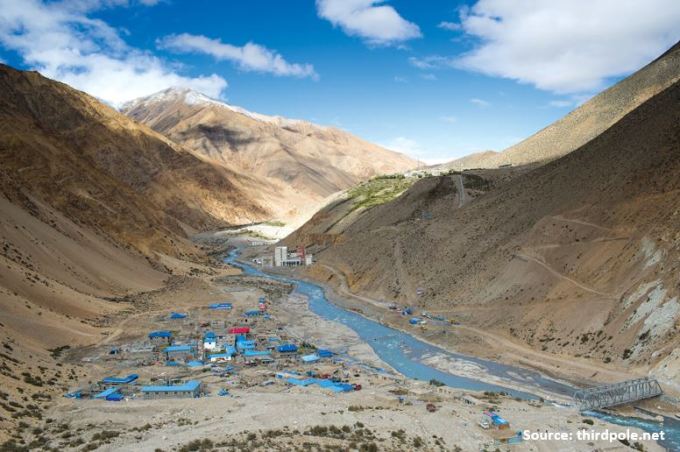The Nepali text version of this article was published on a Birenderanagar based regional daily Sajha Bisaunee
The establishment of hydroelectricity plants in Nepal have visibly clustered around the central and eastern river basins of the country. As such, Province 1, Bagmati, and Gandaki jointly representing Koshi and Narayani river basins have managed to host hydroelectricity plants contributing approximately 96.48% of the total electricity generated within the country as of today. On the contrary, Karnali and Sudoorpaschim provinces jointly representing the western river basin of Karnali and Mahakali have reportedly been only able to contribute towards producing approximately 1.27% of the entire current electricity generation in the country amounting to 42.25 MW despite the frontier western provinces having potentiality to generate 24,969.41 MW by theoretical calculations. While there could be sufficient technical and geological justifications behind the observed skewness, substantial weight of the explanation casually draws from the fact that the frontier western regions of the country have also remained the victim of centralized and east-fronted development in the energy sector.
The centralized development and governance in the hydroelectricity sector is yet witnessed in the current federal setup of the country as federal government is solely responsible for raising royalties applicable for hydroelectricity generation, and sharing it across the three tier governments pursuant to schedule-4 of the Intergovernmental Fiscal Arrangement Act, 2015. This legislative feature regarding a crucial aspect of fiscal federalism directly recognizes subnational governments merely as the passive agents of the entire procedure concerning administration of royalties obtained from the hydroelectricity sector.Whereas, the central government persists as the exclusive governing body for issuing permits and collecting royalties from the hydroelectricity producers even after the recent transition towards political and fiscal federalism.
Meanwhile, an important remedy towards correcting the skewedness, or more so encouraging hydroelectricity development in the Karnali and other river basins or the frontier western provinces can come from the narrative of the federalism itself, or specifically the fiscal aspect of it. Speaking of which shall require overhauling the current arrangement for natural resource revenue (royalty) administration in the direction towards devolving the authority for raising and sharing natural resource royalties from federal to provincial governments at least in the hydroelectricity sector. Also, the provincial governments need to be remunerated with higher share of royalty revenue in comparison to what is enlisted at present by Intergovernmental Fiscal Arrangement Act, 2015 in order to justify the added function of entirely administering the royalty revenue from hydroelectricity sector in along with other functions discussed in this article.Speaking of which, the provincial governments also need to be authorized to issue both survey and construction licenses for establishing hydroelectricity at least up to capacity below 200 MW above which the approval of Investment Board of Nepal (IBN) is required. On the similar front, the recently drafted electricity bill being submitted at the federal parliament for approval already directs provincial and local governments to authorize developments of hydroelectricity plants with capacity below 20 MW.
Such devolution of authorities concerning regulation of hydroelectricity sector and administration of royalties raised from hydroelectricity projects at provincial level can precisely incentivize the governments of Karnali and Sudoorpaschim provinces to encourage and initiate investments in the western frontier regions comprising of hugely potential Karnali river basin. The incentive derives from the fact that such activity shall directly boost the revenue of such governments in the form of royalties and licensing fees. In fact, this aspect of fiscal devolution is an expected outcome of the federal effort to regionalize & decentralize development in regions afar from Kathmandu that were historically overlooked by the erstwhile unitary political order.
Besides, given the fact that the entire revenue from electricity, gas, and water industrial classification as per International Standard Industrial Classification (ISIC) for GDP computation represents only between 1.84% – 2.7% of the national GDP in last five fiscal years, the direct economic significance of hydroelectricity apart from rhetorical significance to fuel national economic development is trivial or relatively inconsequential at present. Also, the potentiality for generating hydroelectricity is fairly distributed geographically across the provincial boundaries of the country in exception to Province 2. Hence, given the relative direct economic insignificance of the sector in along with sufficient geographic distribution regarding the potentiality to reap economic benefit from hydroelectricity generation, the possibility for interregional fiscal imbalance and regional fiscal inefficiency & vulnerability to trigger as the result of regional government being unable to manage often volatile nature of windfall resource gains as feared in the study of extractive mineral resources is hugely unlikely. Also, given that the characteristics of activity concerning generation of hydroelectricity from running river resources being visibly different to that of mineral resource extraction, the observations and conclusions from either sector may not be accurately interposed between each other.
Amid all this, the likely interprovincial externality that may arise from exploitation of river basins straddling across multiple provinces can be addressed or resolved through appointment of constitutional agencies as Intergovernmental fiscal council or Inter-coordination and facilitation committee. In fact, specific basin commissions under the authority of the given constitutional agencies may as well be established to address interprovincial externality that may arise in specific river basin from works related to hydroelectricity generation. For instance, a specific basin commission for Karnali river basin under one of the given authorities may be established to handle interprovincial impacts and arrange compensations when hydroelectricity projects established within the authority of Karnali in upstream Karnali basin affects the territorial jurisdiction of downstream Karnali basin falling within the Lumbini province.
Lastly, it is largely in the purview of the National Natural Resource Fiscal Commission (NNRFC) to progress the current nascent resource revenue sharing framework by also incorporating the recommendations provided. Meanwhile, the eligibility of the current sharing framework to be revisited every five years with ample consideration for ideas and effective practices across the world leaves sufficient opportunity to also have this recommendation considered by the commission.
